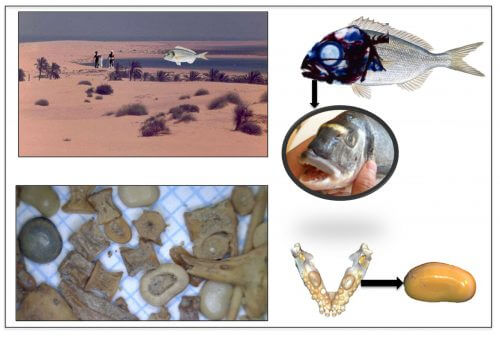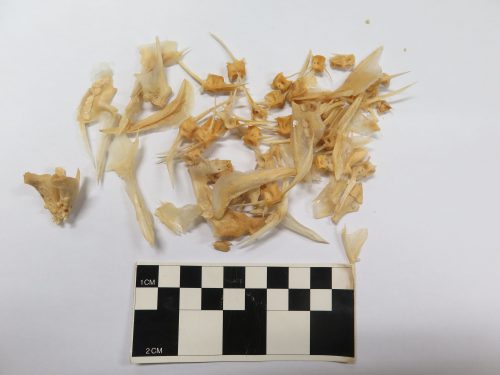In a new study by the University of Haifa, it became clear that the beginning of aquaculture occurs with the stabilization of the sea level, about 3,500 years ago. The imported fish: bream fish from Lake Bradwil in North Sinai. And also: what is the connection to the mythological "Carnival in Nahal"?

The teeth of the bream fish revealed - aquaculture existed in our region already 3,500 years ago, according to a new study conducted at the University of Haifa, Oranim College, the Institute for Seas and Lakes Research and German researchers from the University of Mainz and Göttingen. According to the study, published in the prestigious journal "Nature Scientific Reports", aquaculture existed in the North Sinai area, and this is the earliest empirical evidence found so far for aquaculture in the world. "According to the new findings, along with additional archaeological findings from the Iron Age, which is the beginning of the Biblical period, we learn that Egypt is becoming a powerhouse of aquaculture, which exports fish to the north, including to Israeli and Canaanite cities," said Dr. Guy Sisema-Ventura, from the University of Haifa, the editor of the study.
Today, in light of the ever-increasing demand for fish consumption, aquaculture is also developing rapidly, for what is known as the "blue revolution". But when did humanity begin the development of systematic aquaculture? "Mural paintings from ancient Egypt, from the third century BC, show descriptions of fishing and cutting fish for trade, but no archaeological-empirical evidence was found for aquaculture in such an early period," explained Dr. Irit Zohar, one of the study's editors.
In the current study, funded by the European Research Foundation (ERC), the German National Research Foundation (DFG) and the Israel Science Foundation (ISF), the researchers found empirical evidence hundreds of years earlier than those frescoes. The research was led by Dr. Sisema-Ventura from the Sea and Lake Research Institute and the Institute for Maritime Studies at the University of Haifa, together with Prof. Bar-Oz, Prof. Omri Larnau and Prof. Ayelet Gilboa from the Zinman Institute of Archeology at the University of Haifa, Prof. Dorit Sivan from the Department of Maritime Civilizations of the University of Haifa, Dr. Irit Zohar from Oranim College and the Zinman Institute of Archeology at the University of Haifa, Prof. Andreas Pak from the University of Göttingen and Prof. Thomas Tutkin from the University of Mainz.
The research was based on an examination of the composition of the oxygen isotopes in the bream's teeth - a test that allows identifying where the fish grew up in the last months of its life when the tooth was formed. "The ratio between the isotopes of oxygen 18O and 16O changes in nature regularly depending on the temperature of the water and its level of salinity. Therefore, tracking the ratio between the two isotopes in the teeth of modern fishes and the teeth of archeological fishes makes it possible to identify and reconstruct the temperature and salinity at which the tooth was formed. Once we know this, we can cross-reference this with geological, archaeological and other historical evidence regarding seawater temperatures in different regions and identify the possible habitat of the fish, and the period in which it lived", explained Dr. Sisema-Ventura.
In the current study, over 100 sea bream teeth were sampled from various archaeological sites in Israel. These included coastal sites, such as Dor and Ashkelon, as well as sites located inland, such as Jerusalem and Hazor. The variety of fish teeth studied covered a chronological sequence spanning over 10,000 years, from the beginning of the Neolithic period (the beginning of agriculture) to the early Islamic period (7th-8th centuries AD).
From the findings it became clear that in ancient times, 3,500 years ago, bream fish were caught in two main areas: in the open sea and in coastal lagoons with ancient salinity. However, about 3,500 years ago, with the stabilization of the sea level, a change took place and most of the fish were caught in one habitat: the brackish lagoon of Sabahat Bardwil in North Sinai. "The test of the ratio between the isotopes testified to the temperature and salinity in which the fish were raised starting from that period. "When we looked at all the possible sites, only the brackish lagoon of Birdville matched this specific chemical marker," the researchers explained.

It was also found that in biblical times the bream was the main imported fish to the sites in the center of the country. The size of the fish also indicated the transition to aquaculture. In the periods before 3,500 years, the fish that were caught were in a wide range of sizes, large and small, starting from 3,500 the range of sizes was reduced until in the biblical period the imported fish converged to "the size of a plate", "about 500 grams and a length of about 40 cm, as you can see In fish that are raised in today's aquaculture," said Dr. Zahar.
The new findings, along with other archaeological findings from the Late Bronze and Iron Age, testify to the maritime agriculture and trade relations between Egypt - the great empire to the south, and the ancient settlements in Canaan and Israel. According to the researchers, with the progress of the years, there is an increase in the frequency of fish coming from Egypt: sea bream from the Bradville, Nile princess fish from the Nile and other Nilotic species. These fish were dried and reached the settlements in the Canaan region on the main trade route - and in fact, in most settlements from the period, the researchers find almost exclusively fish imported from Egypt and not local fish from Jaffa or Ashkelon - for example. "It is possible that these findings indicate that in those periods, the residents of the Land-Israel space were almost not engaged in fishing, even in the coastal cities," they said.
Prof. Bar-Oz leaves the conclusion to the mythological song of the Nahal band, "Carnival in Nahal". "Fishing in Bardville was a major branch of the economy in the Nahal-Yam settlement that existed on the banks of the Hima in the 60s, and therefore the song 'Carnival in the Nahal' includes the line 'fishing in Bardville.' Thus, without knowing about it, they renewed a tradition of thousands of years of fishing and trading with the sought-after bream fish", he concluded.

One response
But this is not aquaculture, this is fishing.
Just as hunting is not similar to raising sheep and cattle or as gathering is not similar to growing wheat in the field, so fishing is not aquaculture.